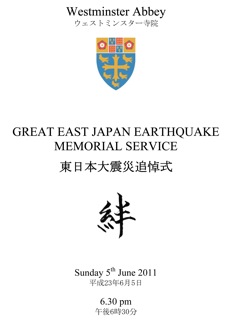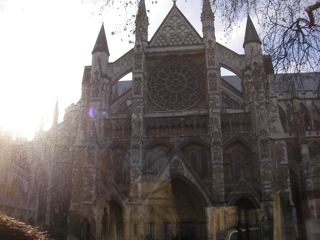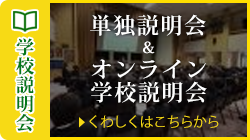

主日礼拝で、高野チロンドンのウェストミンスター寺院で行われ、ご自身も司式者をつとめた東日本大震災追悼式についてのお話がありました。
式の中で、サザーク大聖堂のIpgrave大執事が松尾芭蕉の「奥の細道」から、立派らしいお説教をなさいましたが、その全文を本校のホームページに掲載する許可を頂きましたので、以下にご紹介致します。
* * * * *
Great East Japan Earthquake Memorial Service
A bit over three hundred years ago, the poet 松尾芭蕉, Matsuo Bashō, reached the bay of 松島, Matsushima, in what we now call 東北, Tōhoku as he travelled along his 奥の細道, Oku no hosomichi: ‘narrow road to the far north’. He wrote of Matsushima:
島々の数を尽くして, そばだつものは天をゆびさし, 伏すものは波にはらばふ。
There are an inexhaustible number of islands, some steeply rising, pointing at heaven, some lying, prostrating themselves on the waves … There are some that carry others on their backs, some that hug others in their arms, as if loving their children, their grandchildren. The green of the pines comes in delicate shades … Matsushima is ineffable, made up like a beauty’s face. The Creator’s heavenly handiwork – who can use his brush or exhaust words to his satisfaction?
造化の天工, いづれの人か筆をふるひ, ことばを尽くさむ。
Bashō’s words are a lyrical description of the humanity of the Japanese landscape; utterly entranced, he wrote that night, ‘mouth shut, I tried to sleep, and could not.’
Matsushima is in the heart of the Great East Japan Earthquake zone. In the space of a few minutes on 11th March this year, the landscape of that region turned from cradling humanity to utter horror. I will not rehearse the facts now; they are summarised on the service sheet. Matsushima itself was spared the worst effects of the tsunami, but were Bashō to revisit, the region he would surely once more find himself ‘mouth shut, trying to sleep but I could not’: yet this time not for entrancement, but with dumb horror. The very landscape which had mirrored and cradled humanity had turned against its people.
How can faith respond to a situation like this? The Japanese theologian Kosuke Koyama describes how he felt in August 1945 at the end of the war in a Tokyo virtually destroyed by air raids: ‘Physically and mentally exhausted from the lack of food and sleep from the fear of death … I stood like a ghost an once again and saw the city. As far as my eyes could survey it had become a wilderness. Familiar landmarks were gone; rice shops, temples and shrines at which people had prayed … even railway stations had disappeared … The land, it seemed ‘had vomited out its inhabitants’. And the words which came to Koyama were those of Jeremiah 4:
見よ, 大地は混沌とし空には光がなかった。...山は揺れ動きすべての丘は震えていた。
I looked on the earth, and lo, it was waste and void; and to the heavens, and they had no light. I looked on the mountains, and lo, they were quaking, and all the hills moved to and fro.
Faith must speak into the devastation of both physical landscape and human society. Unlike for Koyama in 1945, for us in 2011 this devastation comes not from human actions but natural forces; that makes it all the more challenging for faith. How can faith respond to a situation like this? There are three kinds of words which faith gives us – though each can only be spoken after a proper reserve, a reverent silence.
Firstly, faith gives words to express grief, pain, sorrow, maybe even anger. Jeremiah, whose words came naturally to Koyama, is the prophet of grief and sorrow par excellence. For humans confronted with individual stories of loss, with the multiplication of those stories into an immensity of suffering and pain, there is need to express sorrow in the deepest language of our hearts; and faith provides that language. Some of the most poignant images of the earthquake have been of rescue workers, their hands joined in prayer to comfort the souls of those whose bodies they have found; the dignity, courage and patience of the Japanese people in expressing their sorrow has humbled us all.
Secondly, faith challenges us with words of love, the love we owe to our brothers and sisters in adversity. This impulse of love is known to every human being; it is an imperative of faith for those who believe. It has been evident in the selflessness of so many caught up in the calamity, their first thought the safety of family, friends, neighbours; in the perseverance and bravery of rescue workers; in the generosity of those who provided shelter, food and comfort; in the readiness of volunteers to risk their health and life safeguarding the damaged nuclear plant; in the ongoing commitment of tens of thousands to rebuilding devastated communities; in the response of people worldwide to appeals like that of the Red Cross Tsunami Appeal. Christians, Buddhists, followers of Shintō, members of newer Japanese religions have all committed together to this loving response of faith. The task has been even more challenging because of the damage and loss their own buildings and people have suffered; I know that is so for the 日本聖公会, Nippon Seikōkai, and it must be true for others also. But they have kept going; as it says on the badge I have worn for the last ten weeks: がんばれ日本! がんばれ東北! Gambare Nihon! Gambare Tōhoku!
Lastly, faith comforts us with words of reassurance and of hope, words we need after a trauma like this. We need to know that the vision of Bashō is not misplaced: that the world in which we live is truly a place where we belong, a landscape in which we can trace our familiar humanity. Of this all the world’s religions speak with assurance: that there is a secure place for us in the cosmos, a place we find through reverence, humility, the limitation of our desires. However we explain it, the natural world, ‘the Creator’s heavenly handiwork, 造化の天工, is our home. And our second reading this evening goes further still, for it speaks not only of natural landscape restored but of human community renewed. The Book of Revelation shows a city transfigured and enlarged through the inclusion of all the peoples and languages of the world. Those who have died and those who are yet to die, all have a place in God’s purposes for his people. In this transitory world, with all its pain and all its beauty, our human vocation is to live life fully with our God:
He will guide us to springs of the water of life, and God will wipe away every tear from our eyes.
命の水の泉へ導き, 神は我らの目から涙をことごとくぬぐわれるからである。

